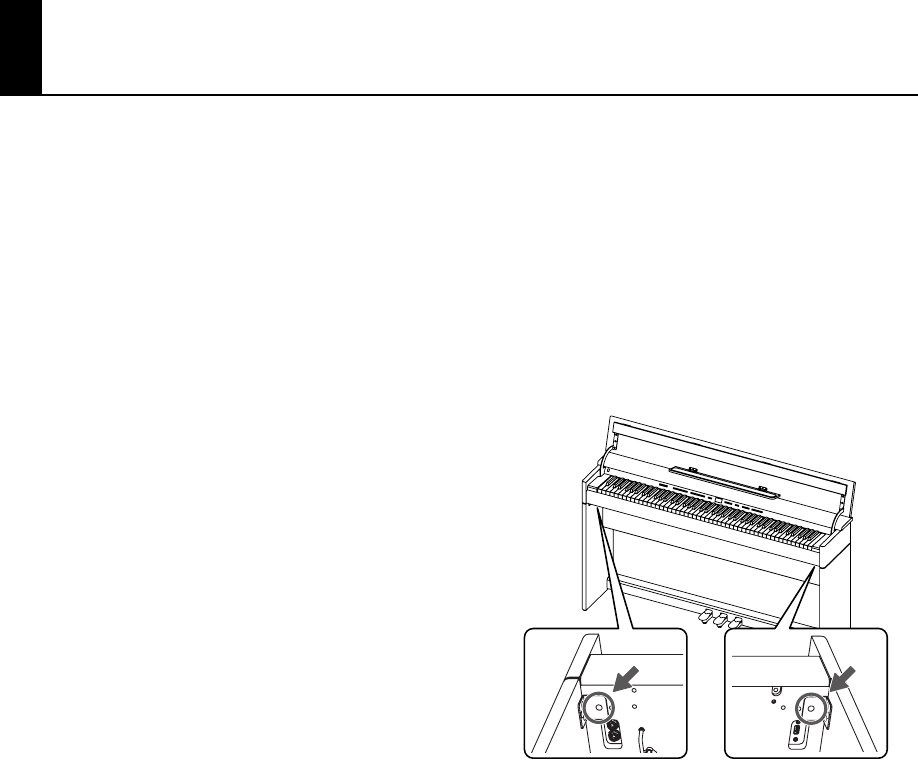
11
IMPORTANT NOTES
Power Supply
• Do not connect this unit to same electrical outlet that is being used
by an electrical appliance that is controlled by an inverter (such as a
refrigerator, washing machine, microwave oven, or air conditioner),
or that contains a motor. Depending on the way in which the
electrical appliance is used, power supply noise may cause this unit
to malfunction or may produce audible noise. If it is not practical to
use a separate electrical outlet, connect a power supply noise filter
between this unit and the electrical outlet.
• The AC adaptor will begin to generate heat after long hours of
consecutive use. This is normal, and is not a cause for concern.
• Before connecting this unit to other devices, turn off the power to all
units. This will help prevent malfunctions and/or damage to speakers
or other devices.
Placement
• Using the unit near power amplifiers (or other equipment containing
large power transformers) may induce hum. To alleviate the
problem, change the orientation of this unit; or move it farther away
from the source of interference.
• This device may interfere with radio and television reception. Do not
use this device in the vicinity of such receivers.
• Noise may be produced if wireless communications devices, such as
cell phones, are operated in the vicinity of this unit. Such noise could
occur when receiving or initiating a call, or while conversing. Should
you experience such problems, you should relocate such wireless
devices so they are at a greater distance from this unit, or switch
them off.
• Do not expose the unit to direct sunlight, place it near devices that
radiate heat, leave it inside an enclosed vehicle, or otherwise subject
it to temperature extremes. Also, do not allow lighting devices that
normally are used while their light source is very close to the unit
(such as a piano light), or powerful spotlights to shine upon the same
area of the unit for extended periods of time. Excessive heat can
deform or discolor the unit.
• When moved from one location to another where the temperature
and/or humidity is very different, water droplets (condensation) may
form inside the unit. Damage or malfunction may result if you
attempt to use the unit in this condition. Therefore, before using the
unit, you must allow it to stand for several hours, until the
condensation has completely evaporated.
• Do not allow rubber, vinyl, or similar materials to remain on the unit
for long periods of time. Such objects can discolor or otherwise
harmfully affect the finish.
• Do not allow objects to remain on top of the keyboard. This can be
the cause of malfunction, such as keys ceasing to produce sound.
• Do not paste stickers, decals, or the like to this instrument. Peeling
such matter off the instrument may damage the exterior finish.
• Depending on the material and temperature of the surface on which
you place the unit, its rubber feet may discolor or mar the surface.
You can place a piece of felt or cloth under the rubber feet to prevent
this from happening. If you do so, please make sure that the unit will
not slip or move accidentally.
Maintenance
• To clean the unit, use a dry, soft cloth; or one that is slightly
dampened. Try to wipe the entire surface using an equal amount of
strength, moving the cloth along with the grain of the wood.
Rubbing too hard in the same area can damage the finish.
• Never use benzine, thinners, alcohol or solvents of any kind, to avoid
the possibility of discoloration and/or deformation.
• Since wood will expand and contract depending on how it is used
and the environment in which it is located, products made of wood
may experience a gradual loosening of the screws over time.
To ensure that your piano remains in safe, optimal condition, you
should regularly check the tightness of the screws in the locations
shown in the illustration. If you find that any screws are loose, use a
screwdriver to tighten them.
Maintenance (Polished-finish pianos)
• Since your piano has a polished finish that is as delicate as that found
on finely crafted wooden furniture, it needs careful, periodic care.
• For regular dusting, use a soft, clean cloth and/or a piano-use
feather duster. Be sure to wipe gently. Even tiny granules of grit
can damage the surface of the unit if you use too much pressure
when wiping.
• If the cabinet gets dirty, wipe it with a soft cloth that has been
soaked with water, then squeezed dry. Afterwards, wipe it again
with a soft dry cloth. Do not use any cleaners or detergents, since
they might deteriorate the surface of the cabinet, and produce
cracks. Do not use dusting cloths that contain chemicals.
• If the cabinet’s surface loses its luster, wipe it thoroughly with a
soft cloth dampened with a little of the piano polishing liquid.
• About piano polishing liquid
• Use polishing liquid as directed by the instructions for the
product.
• Use only polishing liquid that is intended for use on polished-
finish pianos. Using any other polishing liquid may cause
scratches, deformation, or discoloration. To purchase polishing
liquid, contact your nearby musical instrument dealer.
• Use the polishing liquid only on the polished surfaces of the
cabinet. Always wipe the surface with the grain using straight,
even strokes. Do not repeatedly wipe the same places using too
much pressure, since that might result in the loss of luster.
• Be sure to keep the polishing liquid out of the reach of small
children. If the polishing liquid is accidentally swallowed, first get
them to vomit, then take them to a doctor.
DP990F_e.book 11 ページ 2010年1月14日 木曜日 午後11時29分


















